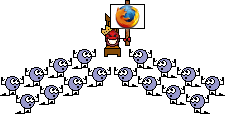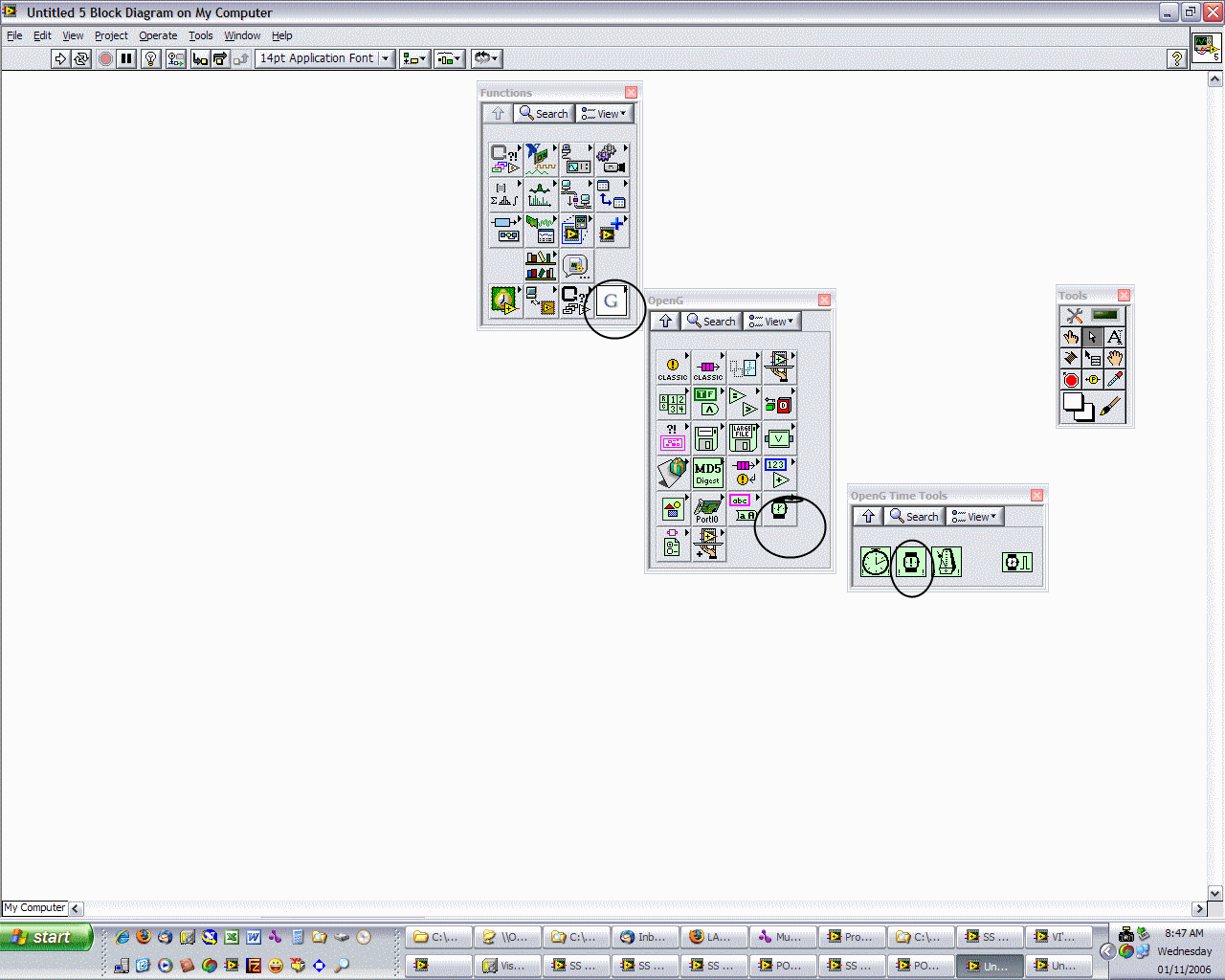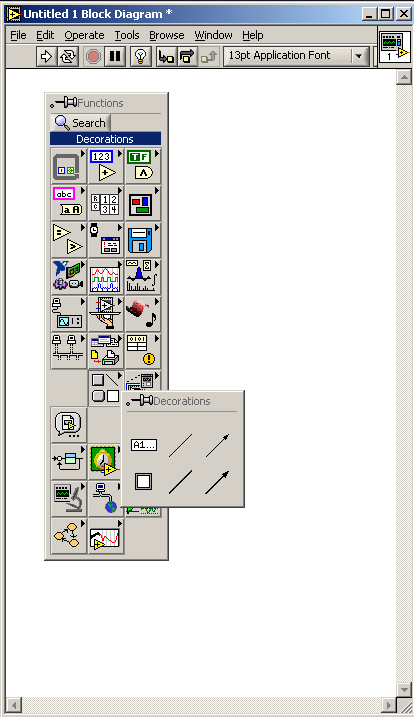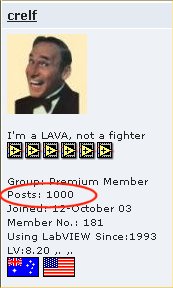-
Posts
177 -
Joined
-
Last visited
Content Type
Profiles
Forums
Downloads
Gallery
Posts posted by peteski
-
-
The problem is that the lines for the security checkpoints for teleportation are even longer than they are at airports, so it doesn't wind up saving you any time.
Yeah, and it is a drag when you have to wait FOREVER for them to get it to work!

-Pete Liiva
-
We also had problems with LabVIEW RT (7.1.1.) and VISA. When VISA write was performed asynchroneously, it caused the RT application to crash after a while.
/J
JFM,
What version of VISA were you running with the 7.1.1 RT? I've recently run into similar issues with VISA serial reads/writes that seemed to be solved by updating the NI-Serial, NI-VISA, and NI-DAQmx. Sorry, in my haste I tried the old "shotgun" approach and it appears to have worked, but I couldn't tell you for sure which did the final trick. My intuition is that it was NI-VISA, but that is just a hunch, "unimpeded" by actual knowledge or hard data.

-Pete Liiva
-
be aware that in the case of clusters you need to get the clustere elements (like Ben showed), in the case of arrays you need to the element type, but be aware that anything you do on the element type will infect the whole array.
Thanks Ton, I was aware of this, which is why I went to doing the cluster thing over the array in the first place. Thanks everybody, I'll be putting this to use in my next "release".
-Pete Liiva
-
Have fun!
Ben
Woo Hoo!!!
Thanks Ben!!
BTW, is there a PDF where all this is mapped out? Something "text" searchable or something like that?
-Pete Liiva
-
Folks,
Here is a request I had recently, and I wanted to inquire if anyone here could lead me to a more elegant way to implement this. I have the need to change the color of an individual display in a cluster based on whether it is within limits or not. This was my recent "quick and dirty" solution. What I really wanted to do is to try to pass a reference of the whole cluster to the subvi instead and parse at the subvi level, but I couldn't seem to get down to the individual background colors of the indicators in the cluster. The approach I came up with works, and I'm willing to stick with it if I have to, but feel there ought to be a better way.
I'd be happy if somebody showed me how to "gracefully" get from the cluster reference down to an individual indicator's "NumText.BGColor", and I could work out the rest. Better yet, If someone pointed me to where in the myriad of LabVIEW manuals such information might be, I'd be quite excited to go there and RTFM!!
BTW, This is LabVIEW 7.1.1, and for this project I am NOT going to 8.XX.
Well, at least that is what I say for now...
Thanks in advance!
-Pete Liiva
-
@Peteski
I agree 2 + 2 = 5 should be for medium values of 2 right?
You know, you would think so... but those <expletive implied> quantum mechanics seem to have a special rule for everything!

And then, when you really try to pin them down, all of sudden everything is "uncertain", bah


-Pete Liiva
-
Mmmmmmmmm pie... 2 + 2 = 5 for very large values of 2 (that's a quote from my advanced quantum mechanics lecturer at University).
I would have thought that 2 + 2 = 6 for very large values of 2, but perhaps I'm forgetting some odd quantum "spin" exclusion thing-a-ma-gig rule or something.

-Pete Liiva
-
First of all I don't knwo the 6122.
But for this kind of acquisition (1 analog and 2 digital) I'd use a 'normal' M-series daq card (6221 too slow, 6251 will do)
Set the clock timing source of the digital input (on port 0 for timed input) to 'Analog sample clock' rising edge.
For the analog input set the trigger start to a PFI-line which has the digital trigger.
Make sure you start all the tasks before the digital trigger arrives.
Now when the trigger arrives the sample clock of the Analog input will start, and thus will start the digital input!
Show your code!
Ton
I agree that the 6251 ought to do the job, although I would like to suggest some caution. Do you know what voltage levels you would be sampling on the analog channel? If they are in the same range as the digital signal, then taking the digital signals as analog inputs could be a good "quick and dirty" way to be sure of "synchronicity". If, on the other hand, you were reading very low voltages on the one analog signal and required a gain change between the channels, the 6251 would be multiplexing through a gain change which could contribute to error on the reading of the analog signal. If this were the case, the 6122 would have the advantage since each channel has its own gain and adc, not a multiplexer feeding one amplifier and ADC like the 6251.
If you want to go the more advanced route and separate the digital and analog channels, a way to be sure of sychronizing them would be to use one of the counter/timers to clock both the DI and the AI reads. That way you could prepare the AI and DI channels first, then setup the counter/timer channel to start triggering your AI and DI reads by triggering off of the external 300 KHz signal. If you do this, the 6251 would not have to multiplex its AI reads at all. Its more work, but you'll learn alot along the way!
Hope this helps!
-Pete Liiva
-
tq for the reply.
ill try again checking using MAX and setting my parameters correctly.
hope i can get it dis time.
thanx.
Ive checked using MAX. when i used the visa write to identify the instrument, the return count value is 6.
then i try to check the read buffer but the error ios VI_ERROR_TMO: Timeout expried before operation completed.
so,what can i do to overcome that problem?
can anyone gimme any suggestions?
thanx in advance.
Your best bet is to show some screen shots of the error and post your code here. If you have a screen shot of what you have in MAX that you call a "return count value of 6" that could help as well. What you have given for information is simply not enough to determine your problem - it could be dozens of possibilities as far as I can see, because so far I've seen virtually nothing.
-Pete Liiva
-
-
I'm in the same situation. I've found that there is a (fairly) easy way to move OpenG Packages to off-line computers. Simply copy the "cache" directory of commander or VIPM to a keyfob. You can then add these packages and install them as you need to.
BTW, this topic came up in the beta stage of VIPM, and JKI has stated that they are working on an easier way to move the packages to non-Internet computers.
:thumbup: Cool! I may look into this shortly. This could come in very handy!
Thanks,
-Pete Liiva
-
Neville and Ton,
Thanks, I had looked at the OpenG toolkits in the past once or twice, though recently I haven't installed them in the project that I'm presently "embedded" in. I may be remembering incorrectly, but it seemed that it was easiest to install OpenG if you had a direct link to the internet, and often our developmental lab computers are specifically left OFF of the internet, for a variety of reasons.
BTW, the example code I "snipped out" was from some older code I had from Labview 5.1.1, well before I had heard of OpenG. It was the quickest and easiest example I could think of to illustrate my point.
I'll have to look into installing OpenG toolkits on one of my connected machines and see what makes sense in the long run for the machines off of the internet.
Best regards,
-Pete Liiva
-
In summary, sequences should only be used to force dataflow (not sequencing, but dataflow).
Yes, I can definately agree to that! Although, in my weaker moments...


-Pete Liiva
-
Rules of (Data) Acquisition #334: "Thou Shalt Not Sequence"
Or there will be consequences ...
Couldn' resist that one, the coffee is great this morning.
I do agree that heavy dependence on sequence structures is a big "no-no" in good LabView design, especially in light of using state machines instead, but I must admit to using them occasionally to force a chain of events without resorting to making a subvi to force it explicitly. For instance:
Essentially, through trial and error I had found that the Stanford Research TIU620 seemed to need a 3 ms wait between the write and the read for this vi to work properly, and this was a quick and simple way to do it. I could have made a small vi as well to do the same thing, but didn't bother to. I find using the "box" of the sequence structure to force some data dependencies convenient, particularly at the end of execution of multiple parallel loops, where I want to make sure all the loops have cleanly exited before commencing with the next step.
Just my :2cents: !

-Pete Liiva
-
Huh? Don't you guys have a Decorations sub-pallete in your BD Functions pallete? I have one in 7.1. It has lines, arrows, a text box, and a frame.
Although I've never used it, I agree with Gary in that I have a Block Diagram Decorations sub-pallet. It doesn't have as many options as its Front Panel "cousin", though.
It also has been possible to paste jpegs and probably a few other picture formats to front panels and diagrams for some time. If I recall correctly, back in the 5 to 5.1.1 (and perhaps before) Windows Labview versions only window's bitmap (.bmp) files could be pasted.
I'm unsure of the Macintosh capabilities history on this, I left that Labview platform back arround 1996.
-Pete Liiva
-
-
I'm missing an outer loop that inserts another beer into the system

/J
Well, you know, some people really can only handle one beer!



On another note, perhaps some of the more libationary among us really need parallel beer loops, or perhaps two loops (timed, perhaps) one named shot (with some sort of passed to it variant) and one named chaser.
Then again, for the Johnny Lee Hooker fans, there could be THREE parallel loops, one named Bourbon, one named Scotch, and one named Beer! :thumbup:
I'm afraid I'm going to have to code and Ibuprofen loop after this post!!!
-Pete Liiva
-
It costs less than Lagavulin, I found this online shop that sells Caol Ila at 44$ a bottle
http://www1.shopping.com/xFS?KW=caol+ila&x=0&y=0
If you ever go to Scotland, you must visit Islay. Me and my wife bicykled all over Scotland 10 years ago, and we both liked Islay a lot.
Whether it's due to the good whisky I don't know, but we had a really pleasant stay at a small Guest house close to Port Ellen. Kintra was the name I belive.
/J
Yes, I have to agree! My wife and I both found the Scottish to be very friendly, and perhaps the people on Islay even a little more so! We stayed at a B&B where we had some excellent home cooked meals! It was a little north of Port Ellen if I remember correctly. If I remember when I get back home I might look it up and post it.
If you go to Islay, I would suggest at least taking a short diversion to the opposite side of the penisula where you catch the ferry to go Islay and at least get a good view of the Isle of Arran, its a breathtaking view! We didn't have the time to see if it was practical to explore the island, as we had a 3 month old new born with us at the time, but if we go back we will probably see what is possible!
-Pete Liiva
-
Hello all,
I am creating a simulator using WinXp Pro and Labview 8.0 which communicates to a device serially using RS-485. The serial bus is at 115.2kbaud.
The device sends a command to the simulator in a polling fashion, where the command is sent every ~2msec. The device does not wait for any acknowledgement or response, and will send another cmd in the next ~2ms... over and over. I need to send a complete response to the command before the device sends it's next command (the 2ms window).
Using an oscilloscope and the application I wrote (set VISA comm--->while loop with serial read then write, no delays) I have noticed that it takes anywhere from 1 to 2.7ms(always varies) for my simulator computer port to write to the data bus. If it takes longer than 2ms to write, the data overlaps and the device craps out.
I am pretty sure the problem is not labview and that its a windows to port issue.
Does anyone know how I can reduce the winXP delay to the serial port?
note: I have observed that when I first start my Labview application it transmits very fast ~700uS, but after ~ 2secs it slows down to 2.7mS
any input would be much appreciated
thx
e
I've been doing highly timed serial port writing using LabViews ETS RTOS v7.1.1. The one restriction that I found kind of obnoxious is that I had to use the motherboard's serial ports, as I was using a "standard" Pentuim 4 computer and there are no RTOS drivers for NI's multi-port serial cards (which we have several of from a former project). Besides that one problem, I've found that I could reliably time serial writes with about 60 microseconds of jitter, as measured via oscilloscope. In my application, I have to write certain charaters at certain times within a 35.7 millisecond window, at a baud rate of 115,200.
Another option, if you got the money and time for it, would be to try to program one of NI's FPGA's to do something similar. That could probably get the timing jitter down even farther.
Hope this helps,
-Pete Liiva
-
 actually, I didn't make myself clear - we moved from Australia to the USA, so we're now on the opposite side of the world from where we started
actually, I didn't make myself clear - we moved from Australia to the USA, so we're now on the opposite side of the world from where we started 
Oh, well that sounds much more reasonable, although having been a "married ex-pat with wife alongside" once myself (albiet for only 7 months) I did find that I missed being close to family and friends.
I'm hoping to get oer to Scotland myself in the next two or three years to trek the Whisky trail - care to join me? Remember: God invented whisky to stop the Scots from taking over the world!
Remember: God invented whisky to stop the Scots from taking over the world!Who knows, two or three years might make that possible! Right now I'm working a space flight project that I predict is going to "slam me down to the mat" through most of 2007. My wife and I talk from time to time about revisiting Scotland, the UK, and possibly Ireland. We also need to stop by Belgium, as our older son was born there when I was an ex-pat there back in '97. He has got to see Gent sometime soon.
One last note on Scotch, another favorite of my wife and I is Ledaig, which is from the Isle of Mull. We haven't visited that part of Scotland, though. At least not yet!
Cheers,
-Pete Liiva
-
My wife and I:
1) we were raised in completely difference environments (country vs city, religious vs hippy, calssical music vs Bob Dylan)
2) one of us is a conformist, the other isn't
3) we now live on the opposite side of the earth
4) I love Scotch (I'm in a JW Blue phase at the moment), she loves good tea, and with both enjoy a really good cigar (like those delicious Monte Cristo Especials from Cuba
 )!
)!Chris,
Sorry to hear about you and your wife living on opposite sides of the world, I can only imagine thats got to be rough one way or another...
JW Blue, eh? I've never quite had the fortitude to fork out the $$ for that scotch. Have sometimes been tempted, though. My wife and I are big fans of sigle malts from the island of Islay, particularly Lagavulin, Laphroig, and Ardberg. These three distilleries happen to sit right next to each other on the island. Back in 1997, my wife and I visited Laphroig sometime between Christmas and New Years Day, and got an excellent tour from the guy who was the general manager of the distillery. He was able to field questions from my wife (a PhD chemist) and myself (MS ME - more or less systems engineer) effortlessly. Friendly "bloke" to boot!
Take care,
-Pete Liiva
-
I remember someone once saying that Bob Saget was te most likable person on the face of the earth - so likable, you just can't surpress the urge to punch him...
Thanks Mike and Chris!! I feel much better now! (I really do!)
:beer:
Cheers,
-Pete Liiva
-
Seeing this, I can't help noticing the parallels with this and my wife and I...
except that...
1) we are completely diferent
2) we are both non conformist
3) we were born on opposites sides of this Earth (approximately)
4) We Both Love Scotch, and really love the Good Stuff!!
Vive la difference, but don't also forget to enjoy the parallels!
That's what makes life :thumbup: !
-Pete Liiva
-
...and yet so right

OK, I gotta confess, I have NO recent popculture life. I have to fight for every Ultimate Frisbee moment I can get, and the fight is on multiple fronts... sometimes I win, sometimes I lose...
Who the %#!! is Bob Saget???
?
-Pete Liiva








The 5th dimension
in LAVA Lounge
Posted
And just how certain are you of where you are, dear sir?